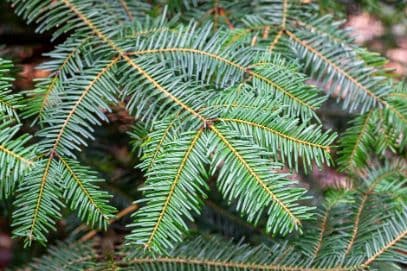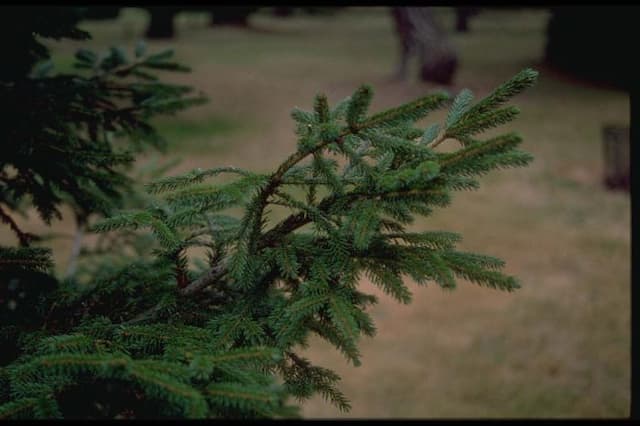Weymouth pine Pinus strobus



ABOUT
Pinus strobus is an evergreen coniferous tree growing to a height of around 80-100 feet and a diameter of roughly 1-3 feet. Its bark is grayish-brown and flaky, often appearing in thin vertical strips. The tree has a distinct pattern of whorled branches as it matures and its needles are soft and bluish-green, measuring 5-10 inches in length and 0.01-0.04 inches in width. Its cones are round and slender, measuring 4-8 inches long and 1-2 inches wide. The cones have scales that are curved, pointed, and measure 0.2-0.4 inches long. The tree's seeds are 1/4-1/2 inches in length and light brown in color.
About this plant
 Names
NamesFamily
Pinaceae
Synonyms
Weymouth pine, Eastern white pine, North American pumpkin pine, North American white pine, White pine, Soft pine
Common names
Leucopitys strobus, Pinus nivea, Pinus tenuifolia, Pinus umbraculifera, Strobus strobus, Strobus weymouthiana
 Toxicity
ToxicityTo humans
Pinus strobus is generally considered to be non-toxic to humans.
The sap of this plant has been known to cause skin irritations, however, and people with a sensitivity to it can develop a rash when exposed. Ingestion of the needles or sap can cause minor gastrointestinal discomfort, including nausea and vomiting. If large quantities are consumed, it can lead to more serious effects and should be monitored by a doctor.To pets
Pinus strobus is not toxic to animals. Although its needles and cones can be somewhat unpalatable when eaten, no toxic effects have been reported from ingestion.
 Characteristics
CharacteristicsLife cycle
Perennials
Foliage type
Evergreen
Color of leaves
Green; blue
Height
Up to 100 feet
Spread
Up to 3 feet
Plant type
Tree
Hardiness zones
4
Native area
North America
Benefits
 General Benefits
General BenefitsPinus strobus is known to be fire resistant, meaning that it is able to survive through an overwhelming fire and remain intact.
This plant provides excellent wildlife habitat potential due to its wide canopy and thick bark, making it an ideal home for a variety of animal and bird species.
Pinus strobus is a highly valuable timber species due to its straight grain and light color, making it a popular choice for construction and carpentry projects. Medical Properties
Medical PropertiesPinus strobus has been used effectively to treat fungal infections.
The inner bark of Pinus strobus has been used to treat inflammation and reduce pain.
Compounds from Pinus strobus have been used to heal wounds in traditional medicine.
A compound found in the essential oil of Pinus strobus has been used to help treat asthma and other bronchial issues.
Pinus strobus has been used to help support the immune system and strengthen the body's defenses.
Extracts from Pinus strobus bark have been used to help improve memory and focus.
inus strobus can help reduce stress, anxiety and depression naturally. Air-purifying Qualities
Air-purifying QualitiesThe Pinus strobus plant is known for its air purifying qualities. Its needles contain compounds known as terpenes, which help to absorb airborne pollutants and volatile organic compounds, which helps to improve the quality of the air around it. Additionally, the tree's needles release natural oils that help to reduce mold build-up, which improves air quality as well.
 Other Uses
Other UsesPine strobus is commonly used as a mulch due to its longevity and light weight.
The plant's wood is used to create charcoal due to its abundance and good burning characteristics.
The tree is extensively used for furniture and flooring due to its durability and charming aesthetic
Pine strobus bark is used to get a sumac or yellow dye, commonly used in the textile industry.
This plant's wood is used to make a variety of musical instruments due to its resonance properties.
The tree is used as a windbreak and/or fence due to its tall stature and evergreen foliage.
Pine strobus is a popular crafting and hobby material due to its diverse shape and texture.
Interesting Facts
 Feng Shui
Feng ShuiPinus strobus, or the Eastern White Pine, is an ideal plant to use in Feng Shui due to its energizing and growing nature. To use this plant in Feng Shui, it should be placed in the East to bring in good luck and wealth.
Additionally, Weymouth pine can be used to create a positive energy flow in the home, which can help to promote positive relationships, better health, and increased productivity. Zodiac Sign Compitability
Zodiac Sign CompitabilityAccording to astrology, Pinus strobus could fit best with the sign of Libra. This is because Libra is a sign of balance, justice, harmony, and peace.
 Plant Symbolism
Plant SymbolismSymbolically, Pinus strobus represents longevity, endurance and strength as well as peace and serenity. Its tall, straight form and long lifespan make the Weymouth pine an enduring symbol of stability and tenacity.
Its similarity to the Greek symbol of peace, the olive tree, further emphasizes its associations with serenity, making it a symbol of hope, patience and trust. Furthermore, its hard wood is often used for roofing or furniture building, making it a symbol of quality and craftsmanship.
 Water
WaterPinus strobus should be watered once per week, enough to keep the soil consistently moist.
Water the soil deeply and thoroughly.
Avoid soaking the soil as this could lead to root rot. Light
LightPinus strobus thrives in full to part sun. The best spot for this plant would be in a location that receives at least 6 hours of direct sunlight each day.
 Temperature
TemperatureThe ideal temperature for summers is between 55-75°F and for winters it is between 10°F and 20°F. The plant can survive temperature down to - 20°F and up to 100°F.
 Pruning
PruningPruning Pinus strobus should be done regularly to maintain its shape and encourage vigorous growth. Pruning should be done in late winter or early spring before active growth begins. The principles for pruning Pinus strobus are similar to those used for other conifer shrubs, including removing dead, dying, or diseased branches and cutting back overly long branches. When pruning, make sure to cut back branches to a bud or branch, avoiding shearing. Shearing will create a densely foliated, but weak-structured shrub. Also avoid topping, which can create a large, deep wound with decreased vitality resulting in weakened growth and increased lumber decay.
 Cleaning
CleaningNot needed
 Soil
SoilSoil mix for Pinus strobus: 25% composted pine bark, 25% volcanic pumice, 25% coarse builder’s sand 25% peat moss.
Soil pH needs to be between 6.0-6.5. Repotting
RepottingThis is an outdoor tree, so transplanting is not required.
 Humidity & Misting
Humidity & MistingThe best humidity conditions for Pinus strobus is 40-50% relative humidity.
To increase humidity, mist the foliage regularly and place the plant on top of a pebble tray filled with water. To decrease humidity, reduce misting and keep away from any heat that might dry out the surrounding air. Suitable locations
Suitable locationsIndoor
Not growing
Outdoor
For optimal growth, Pinus strobus should be planted in a sunny area that receives at least 6 hours of direct sunlight each day.
The ideal temperature range for Pinus strobus is between 40-80°F.
Plantings should be at least two to three feet apart.
The soil should be well-draining and of moderate fertility. If soils are poor, additional composted organic matter should be added to the planting area.
Pinus strobus should be watered deeply and consistently throughout the growing season.
Regular applications of mulch to retain moisture and reduce weed growth will help ensure optimal growth.Hardiness zone
USDA 5 - 10
 Life cycle
Life cycleThe life cycle of Pinus strobus begins in the spring with the emergence of the male and female cones. The male cones produce pollen that is carried by the wind to the female cones. The female cones, which are much larger than the male cones, then produce seeds. These seeds then germinate in the summer and begin to grow.
In the fall, the tree begins to form buds for the upcoming spring. The buds will remain dormant until the following spring when they will open and begin to grow. As the tree matures, it will begin to produce cones which will produce seeds.
The tree will continue to grow throughout its life and reach heights of up to 100 ft. After the tree reaches maturity, it will begin to weaken and eventually die. This process can take anywhere from 50 to 200 years. Propogation
PropogationPropogation time
Spring, summer
Seed:
This plant typically germinates within a few weeks of sowing, and should do so when the soil temperature is between 40-80 degrees Fahrenheit. Cold stratification (30-40 degrees Fahrenheit) for two to three months can promote germination for slow-germinating seeds. Plant the stratified seeds 1/4 inch deep in slightly moist, sterile seed starter mix, either in flats or directly in the ground.
Cuttings:
Collect softwood cuttings from the Pinus strobus in late May or early June, when the growing tips of new branches have hardened. Make the cuttings 4-6 inches long, each with two or three nodes (points where leaves are attached). Dip the cuttings into a rooting hormone, then place into pots of soil-less planting media (like equal parts of perlite and peat moss). Keep the cutting moist, and make sure the environment is warm and humid (between 50-65 degrees Fahrenheit). The cuttings should sprout roots within four to six weeks.
 Pests
PestsAphid, Coddling moth
 Diseases
DiseasesHoney fungus, Needle cast









